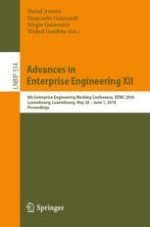This book constitutes the proceedings of the 8th Enterprise Engineering Working Conference, EEWC 2018, held in Luxembourg, Luxembourg, in May/June 2018.
EEWC aims at addressing the challenges that modern and complex enterprises are facing in a rapidly changing world. The participants of the working conference share a belief that dealing with these challenges requires rigorous and scientific solutions, focusing on the design and engineering of enterprises. The goal of EEWC is to stimulate interaction between the different stakeholders, scientists as well as practitioners, interested in making Enterprise Engineering a reality.
The 9 full papers and 3 short papers presented in this volume were carefully reviewed and selected from 24 submissions. They were organized in topical sections named: on architecture; on security and blockchain; on DEMO; and on teaching.
